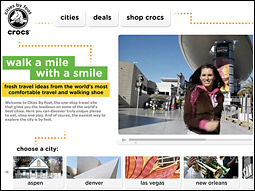Published: July 28, 2008 in AdAge
It’s just common sense that if you give a little, you’ll usually get a little in return. But to paraphrase President Harry S. Truman, that (inadvertent) font of marketing wisdom, “If common sense were so common, more [marketers] would have it.” Marketing is nothing more or less than an exchange of value. The better the value the marketer provides, the more time and attention they’ll usually get back from their target. If the value delivered by the marketer is exceptional, then the consumer will pay back the marketer with loyalty and brand evangelism in good times and bad.
Marketing as service is about transforming your communications from mere messaging into an exceptional value that consumers will seek out. To quote Ad Age Editor Jonah Bloom, “Marketing as service is where brands actually give consumers something they want or need,” as opposed to hitting them over the head with messaging they’d rather zap or ignore. While Ad Age and others have chronicled examples of this savvy approach, no one to my knowledge has put forth a how-to guide for marketing as service, so let’s just say, the buck starts here.
Because of our relentless desire to cut through, we are an industry that always likes to focus on the latest and greatest. Ironically, much could be learned from the past. As President Truman put it, “There is nothing new in the world except the history [of marketing] you do not know.” Ad Age recently reported on a “new path” being pursued by Crocs to help pedestrian explorers with online walking guides. And while Cities by Foot is indeed a fine example of marketing as service, it is by no means a true innovation.

Perhaps you’ve heard of the Michelin Guide. Way back in 1900, André Michelin created a driver’s guidebook to France to help drivers see the best restaurants of the country while keeping their cars in good shape. It included addresses of places such as gas stations, garages, tire repair shops, and public toilets. Set up 108 years before Cities by Foot, the Michelin Guide remains a quintessential example of marketing as service, educating customers, enhancing their lives and doing so in a highly relevant manner.
It’s hard to create a meaningful service for your customers and prospects if you don’t know all that much about them. And while some might choose to follow President Truman’s advice to “Always be sincere, even if you don’t mean it,” it is essential to have a genuine insight when pursuing marketing as service. Find that insight somewhere within the passions and miseries, the days and nights, the aspirations and disappointments, and the loves and hates of your target universe. Genuine insight will uncover a service that matters, a service the target will truly appreciate.
Street cred
Nike spent years hangin’ with action sports enthusiasts before it launched a social network on Loop’d to target them. After struggling to crack the code, Nike learned the hard way that this group is keenly sensitive to “posers” and will call out a false note faster than you can say “backside 360 ollie.” According to a Nike 6.0 spokesperson, “we reach out to our athletes for insight and validation. They are a crucial part of our brand, and we would not be where we are at without them.”
Some marketers have expressed concern about losing control of their brand in this newfangled Web 2.0 world. I urge them to consider these prescient words from the first president to address the American people from the White House, “It is amazing what you can accomplish if you do not care who gets the credit.” My advice to marketers is to just let go, because you aren’t in control anyway. Offer your customers a way to inspire subversive comic books, and reward their creativity with outrageous parties like Colt 45. “The Tales of Colt 45” program, now in its second year, celebrates “the most notable [customer] adventures involving the famed malt liquor” in a four-booklet series that also promote a five-market nightclub tour where new adventures will undoubtedly unfold. Or, like Jones Soda, maintain your cult following by letting your customers design your product labels.
Similarly, T-shirt company Threadless has built a reportedly multimillion-dollar business in eight years by encouraging its customers to submit designs and choose the shirts it will print. Best yet is Etsy, an online marketplace for handmade goods. Etsy has over 1 million registered users that it supports creatively with online classes and resource locations and conversationally with forums, blogs and chat rooms. They have also created a request-based marketplace where buyers can post what they want and sellers can bid on the job. In a recommendation economy, all of these represent powerful ways to drive positive word of mouth and build brand loyalty.
Marketers have a tendency to get tired of their successes far sooner than most consumers. The reality is that when you hit upon a really good marketing as service program, you need to stick with it for a while. Maybe you can’t foresee a 100-year-plus commitment such as Michelin, but how about more than a decade such as Camp Jeep? American Express has offered exclusives for gold- and platinum-card members for more than 20 years, and the BankCab has been driving customers to HSBC for more than six years. And lest we fall victim to the Truman proverb, “Being too good is apt to be uninteresting,” keep things fresh with periodic upgrades, ensuring that your marketing buck never stops working for you.
